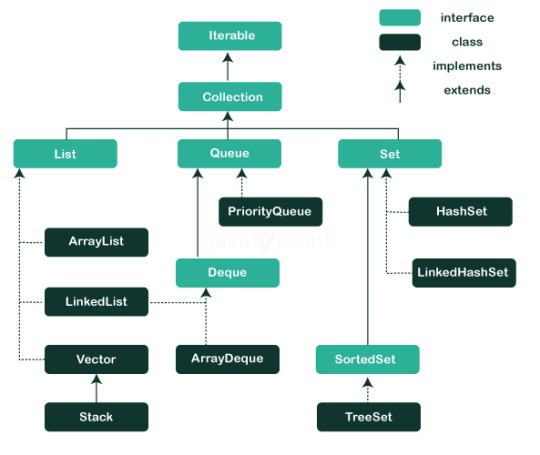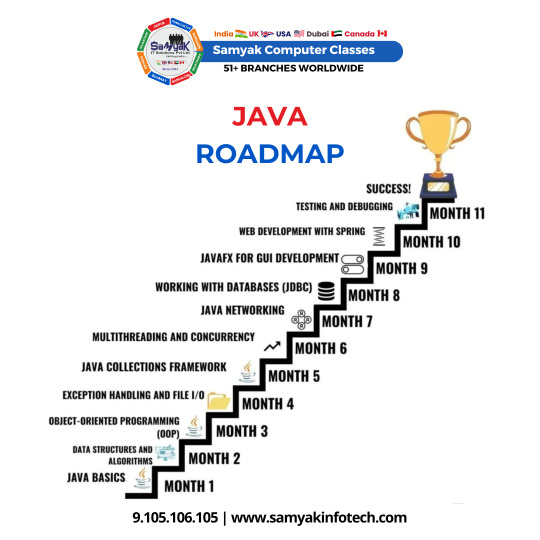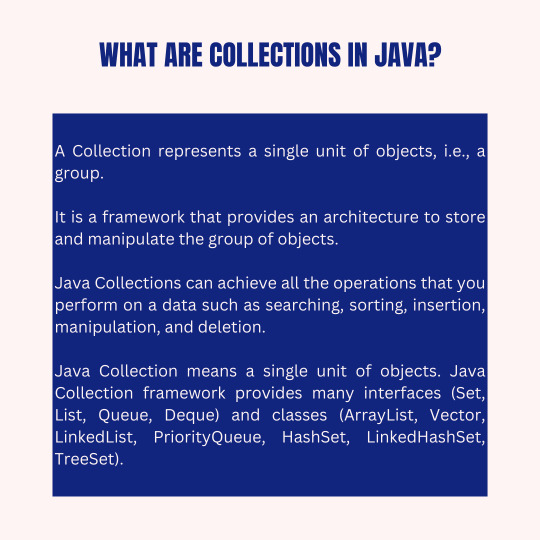#javacollection
Explore tagged Tumblr posts
Text
JavaCollections: Your Data, Your Way
Master the art of data structures:
List: ArrayList, LinkedList
Set: HashSet, TreeSet
Queue: PriorityQueue, Deque
Map: HashMap, TreeMap
Pro tips:
Use generics for type safety
Choose the right collection for your needs
Leverage stream API for elegant data processing
Collections: Because arrays are so last century.
#JavaCollections: Your Data#Your Way#Master the art of data structures:#- List: ArrayList#LinkedList#- Set: HashSet#TreeSet#- Queue: PriorityQueue#Deque#- Map: HashMap#TreeMap#Pro tips:#- Use generics for type safety#- Choose the right collection for your needs#- Leverage stream API for elegant data processing#Collections: Because arrays are so last century.#JavaProgramming#DataStructures#CodingEfficiency
2 notes
·
View notes
Text
📚 Comparing Java Collections: Which Data Structure Should You Use?
If you're diving into Core Java, one thing you'll definitely bump into is the Java Collections Framework. From storing a list of names to mapping users with IDs, collections are everywhere. But with all the options like List, Set, Map, and Queue—how do you know which one to pick? 🤯
Don’t worry, I’ve got you covered. Let’s break it down in simple terms, so you can make smart choices for your next Java project.
🔍 What Are Java Collections, Anyway?
The Java Collection Framework is like a big toolbox. Each tool (or data structure) helps you organize and manage your data in a specific way.
Here's the quick lowdown:
List – Ordered, allows duplicates
Set – Unordered, no duplicates
Map – Key-value pairs, keys are unique
Queue – First-In-First-Out (FIFO), or by priority
📌 When to Use What? Let’s Compare!
📝 List – Perfect for Ordered Data
Wanna keep things in order and allow duplicates? Go with a List.
Popular Types:
ArrayList – Fast for reading, not so much for deleting/inserting
LinkedList – Good for frequent insert/delete
Vector – Thread-safe but kinda slow
Stack – Classic LIFO (Last In, First Out)
Use it when:
You want to access elements by index
Duplicates are allowed
Order matters
Code Snippet:
java

🚫 Set – When You Want Only Unique Stuff
No duplicates allowed here! A Set is your go-to when you want clean, unique data.
Popular Types:
HashSet – Super fast, no order
LinkedHashSet – Keeps order
TreeSet – Sorted, but a bit slower
Use it when:
You care about uniqueness
You don’t mind the order (unless using LinkedHashSet)
You want to avoid duplication issues
Code Snippet:
java

🧭 Map – Key-Value Power Couple
Think of a Map like a dictionary. You look up values by their unique keys.
Popular Types:
HashMap – Fastest, not ordered
LinkedHashMap – Keeps insertion order
TreeMap – Sorted keys
ConcurrentHashMap – Thread-safe (great for multi-threaded apps)
Use it when:
You need to pair keys with values
You want fast data retrieval by key
Each key should be unique
Code Snippet:
java

⏳ Queue – For First-Come-First-Serve Vibes
Need to process tasks or requests in order? Use a Queue. It follows FIFO, unless you're working with priorities.
Popular Types:
LinkedList (as Queue) – Classic FIFO
PriorityQueue – Sorted based on priority
ArrayDeque – No capacity limit, faster than LinkedList
ConcurrentLinkedQueue – Thread-safe version
Use it when:
You’re dealing with task scheduling
You want elements processed in the order they come
You need to simulate real-life queues (like print jobs or tasks)
Code Snippet:
java

🧠 Cheat Sheet: Pick Your Collection Wisely

⚙️ Performance Talk: Behind the Scenes

💡 Real-Life Use Cases
Use ArrayList for menu options or dynamic lists.
Use HashSet for email lists to avoid duplicates.
Use HashMap for storing user profiles with IDs.
Use Queue for task managers or background jobs.

🚀 Final Thoughts: Choose Smart, Code Smarter
When you're working with Java Collections, there’s no one-size-fits-all. Pick your structure based on:
What kind of data you’re working with
Whether duplicates or order matter
Performance needs
The better you match the collection to your use case, the cleaner and faster your code will be. Simple as that. 💥
Got questions? Or maybe a favorite Java collection of your own? Drop a comment or reblog and let’s chat! ☕💻
If you'd like me to write a follow-up on concurrent collections, sorting algorithms, or Java 21 updates, just say the word!
✌️ Keep coding, keep learning! For More Info : Core Java Training in KPHB For UpComing Batches : https://linktr.ee/NIT_Training
#Java#CoreJava#JavaProgramming#JavaCollections#DataStructures#CodingTips#DeveloperLife#LearnJava#ProgrammingBlog#TechBlog#SoftwareEngineering#JavaTutorial#CodeNewbie#JavaList#JavaSet#JavaMap#JavaQueue#CleanCode#ObjectOrientedProgramming#BackendDevelopment#ProgrammingBasics
0 notes
Text
Hierarchy of Collection Framework
Let us see the hierarchy of collection framework:

#java#programming#javaprogramming#code#coding#engineering#computer#computerscience#computertechnology#software#softwaredevelopment#education#technology#javacollections#collections#online
1 note
·
View note
Text
How to Sort a HashMap in Java Efficiently
Discover how to use Java's SortedMap and TreeMap to create a sorted HashMap. Learn about sorting mechanisms, benefits, and practical applications for managing key-value pairs efficiently.
0 notes
Text

Roadmap to become successful in Java. See how you can master Java in a single year.
Build your career in Java: A Clear Path to Success in Programming.
#Java #Javascript #javacollection #javafx #javabasic #Webdevelopment #samyak #samyakcomputerclasses #javascripts #javaprogramming #javadeveloper
0 notes
Link
Very good java arraylist step by step.
0 notes
Text
What are Collections in Java?
Let us see about the collections in Java:

#java#programming#javaprogramming#code#coding#engineering#computer#computerscience#computertechnology#software#softwaredevelopment#education#technology#javacollections#collections#online
1 note
·
View note